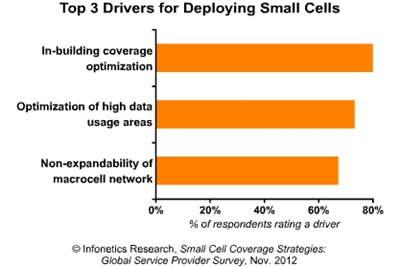2012年11月8日、カリフォルニア州キャンベル-市場調査会社のInfonetics Researchは、最新のSmall Cell Coverage Strategies: Global Service Provider Surveyから抜粋を発表した。この調査内でInfoneticsは、世界中のワイヤレスオペレータや既存、競合オペレータに対し、スモールセルの拡大計画に関するインタビューを行った。

アナリストノート
「世界のスモールセルベンダーが期待している言葉は分かります。でも、スモールセル市場は、多くの人が予測しているような爆発的拡大には向かっていないのが現実です。」
Infonetics Researchでモバイルインフラ、キャリア経済担当の主席アナリストを務めるStephane Teralは、そう警告し、更に次のように続ける。
「現状では、オペレータの大半が未だに、モバイルネットワークのエリアカバーにディストリビューテッド・アンテナシステム(DAS)を使用し続けています。広い場所ではスモールセルでキャパシティ向上を図るという話も多いに聞かれましたが、我々のインタビューしたオペレータらは、モール、空港、スタジアムやその他類似施設において、DASが基本ツールで在り続けると思っています。確かにスモールセルは、3Gや4Gネットワークで重要な役割を果たすことになりそうです。しかし、オペレータはニーズに応じた適切なツールを選ぼうとしています。エリアカバー、キャパシティ、あるいはその両方。もしくは、屋内、屋外、あるいはその両方を必要とする場合などニーズは様々です。スモールセルは常に適切なソリューションという訳ではないのです。結論を言うなら、ここではレジデンシャル・フェムトセルについては触れませんが、スモールセルについてはマクロセルと比べてごく小さな市場に留まり、意味ある普及率まで到達するにはかなりの時間を要することになるでしょう。」
スモールセルのエリアカバー戦略調査のハイライト
- Infoneticsがインタビューしたオペレータの73%は既に、家庭や企業等を中心にスモールセルを展開しており、フェムトセルを多く使用している様子が伺える。
- スモールセルを展開しているオペレータのうち4分の3は、世界を通じて最も一般的な周波数帯である1.5GHz-2.2GHz帯を使用している。
- 回答オペレータの80%は現在、エリアカバーの最適化を求め、携帯ネットワークにDASを利用している。
- 昨年と同じように、スモールセルを配備する理由のトップは、屋内カバーエリアやデータ利用度が高いエリアの最適化、マクロネットワークの非拡張性である。
- 調査に回答した企業は、スモールセル配備の障害になる理由として、昨年調査から14%低下したがマクロネットワークとの干渉を第一位に挙げた。
- パブリック・アクセス・スモールセルに求める機能の中で、インタビューしたオペレータが最も評価したのは、自己組織化ネットワーク(SON)の機能であった。
For its 27-page small cell coverage strategies survey, Infonetics interviewed independent wireless, incumbent, and competitive operators from Europe, North America, Asia and Latin America about their small cell buildout plans. The study provides insights into small cell deployment plans and drivers, technical challenges, implementation barriers, deployment locations, spectrum ranges, and DAS usage.
(原文)
Small cell is the buzz but DAS is the biz, say operators in latest Infonetics survey
Campbell, CALIFORNIA, November 8, 2012-Technology market research firm Infonetics Research released excerpts from its just-published Small Cell Coverage Strategies: Global Service Provider Survey, for which Infonetics interviewed wireless, incumbent, and competitive operators around the world about their small cell buildout plans.
ANALYST NOTE
"To the small cell vendors of the world, we know what you want to hear, but what you need to hear is that the small cell market simply isn't going to explode as many are predicting," cautions Stephane Teral, principal analyst for mobile infrastructure and carrier economics at Infonetics Research.
"The reality is," Teral continues, "a majority of operators are still using distributed antennas (DAS) in their mobile networks for coverage, and despite all the talk about using small cells to boost capacity in large venues, operators we interviewed believe DAS will remain a fundamental tool for malls, airports, stadiums and the like. Yes, small cells are poised to play a major role in 3G and 4G network expansion, but operators are going to pick the right tool for their needs, be it coverage, capacity or both; indoor, outdoor or both; and small cells aren't always the right solution. The bottom line is, small cells -- I'm not talking about residential femtocells here -- remain a tiny market compared to macrocells, and will take time to reach meaningful penetration."
SMALL CELL COVERAGE STRATEGIES SURVEY HIGHLIGHTS
- 73% of the operators Infonetics interviewed have already deployed small cells, mainly in homes and enterprises, indicating solid experience with femtocells
- Of those that have deployed small cells, 3/4 have done so using the 1.5GHz-2.2GHz spectrum, the most common band across all geographic regions
- 80% of respondent operators currently use DAS in their cellular networks for coverage optimization
- Like last year, the top drivers for deploying small cells are optimizing in-building coverage and high data usage areas, and non-expandability of the macro network
- Survey respondents rate interference with the macro network as the #1 barrier to deploying small cells, although falling 14 percentage points from last year's survey
- The highest-rated feature for public access small cells among operators interviewed is self-organizing network (SON) capabilities

